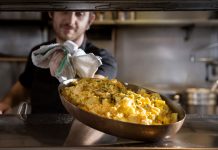
Courtesy of Shannon Jenkins, Flaming City Photography
One of the most anticipated (and long-delayed) restaurants of the year, Ink & Elm opens tomorrow at 1577 North Decatur Road in Emory Village. A triple threat with a casual tavern, a more sophisticated dining room, and an old school lounge, Ink & Elm was developed to meet the growing needs of the neighborhood. Below, executive chef Stephen Sharp shares the details.
How did you get involved with Ink & Elm?
I’ve known [Ink & Elm partner] Hunter Jefferson for years. About two years ago, he contacted me and asked me to open a restaurant with him. I was executive chef at Blue Ridge Grill or F.A.B. (or wherever I was at the time), and we started looking for spaces. We met [now partners] Keith Osborne and Nick Chaivarlis, found a space, and then formed our concept based off of the space. Keith is from this area so he had more of a feel for the everyday life in Emory Village and what it was lacking as far as cuisine. There’s not a restaurant on this strip that’s open in the p.m. unless you consider Zoes or Doc Chey’s. So there was an allure to it.
How did you come up with the concept?
It was a large buildout. We had two spaces to work with: formerly a florist and Park Bench. Ai3 had this brilliant idea of running it as two spaces. From there, we started building our concept for food. We wanted to do local, approachable, seasonal, simple cuisine. We didn’t know if it would be fine dining or a rustic, tavernish pub. We were able to do both.
How do the dining room and tavern differ?
On the tavern side, it’s a little more cozy, darker, dimmer, more of a tavern pub feel. We wanted to impart that into the food we were doing for the space. The other side was the dining room. It was bigger, more airy, more light. So we built off of that and wanted to make that the destination restaurant for this neighborhood. We’ll do more local and seasonal [fare] here. I think of the tavern as bourbon and beer and the dining room as wine and champagne.
We also have a lounge in the middle, catering directly to the restaurant. It has leather elements: big throwback seats, wingback chairs, and bistro tiling. We wanted to do an oyster bar, highlight three to four oysters per week, plus have a couple of cooked preparations as well as charcuterie and cheeses.
In the daytime we’ll have a barista for coffee and serve fresh scones, muffins, and cinnamon rolls in the morning. In about a month we’ll start doing some food truck-style sandwiches five days a week, presented in to-go boxes on the tavern side.
What’s the attire for each area of the restaurant?
As a whole, it’s definitely a casual atmosphere. You could walk into the tavern in the same thing you’d wear to the dining room. We’re trying to be a neighborhood spot. We’re not trying to be pretentious. The dining room offers more fine dining fare but it is not white tablecloth. You’ll just see a different cuisine. The tavern is more casual than the restaurant, but both intertwine with each other pretty well.
The menu looks pretty small. Why is that?
I had to approach it with a little bit of caution because there are three entities operating out of one kitchen. I didn’t want to overstep my boundaries and get too far over my head and not be able to execute the dishes we are doing.
So the menu may change?
I’m approaching it with care at the beginning, with aspirations for where we can go in the future. There are tried and true items, but I like to mix it up and, conceptually, things sound great but they have to work. Trial and error is ninety percent of what our business is all about.













